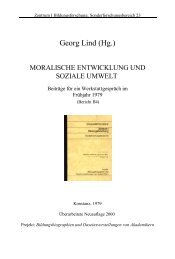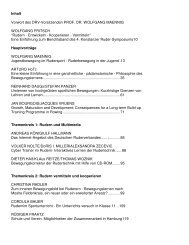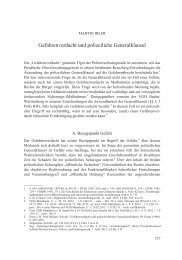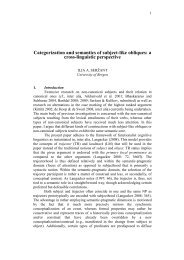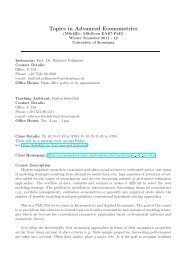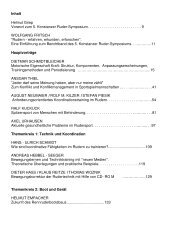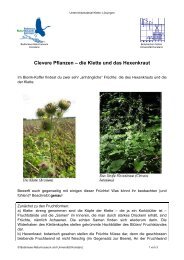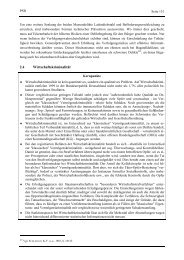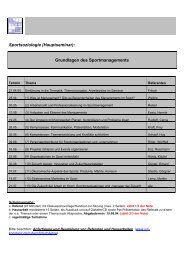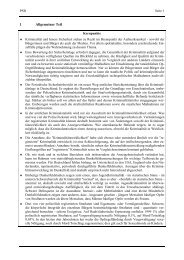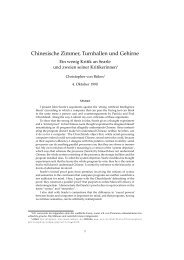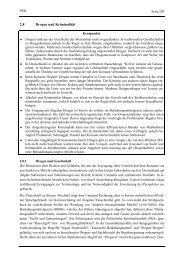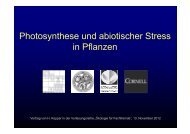Book of Abstracts Book of Abstracts - Universität Konstanz
Book of Abstracts Book of Abstracts - Universität Konstanz
Book of Abstracts Book of Abstracts - Universität Konstanz
Create successful ePaper yourself
Turn your PDF publications into a flip-book with our unique Google optimized e-Paper software.
The magnetic moments <strong>of</strong> isolated metal clusters<br />
Gereon Niedner-Schatteburg 1 and Wilfried Wurth 2<br />
1 Fachbereich Chemie, TU Kaiserslautern, Germany (gns@chemie.uni-kl.de)<br />
2 Institut für Experimentalphysik, <strong>Universität</strong> Hamburg, Germany (wilfried.wurth@desy.de)<br />
B - 39<br />
Within the last fiveteen years X-ray Magnetic Circular Dichroism (XMCD) has made itself<br />
useful in solid state physics and in surface science [2] since it allows for the elucidation <strong>of</strong><br />
magnetic properties that would be unavailable otherwise. For chemists XMCD has become a<br />
valuable tool when investigating paramagnetic organometalic and coordination compounds [2].<br />
In a few cases even paramagnetic metalloproteins have been studied successfully [3]. Only<br />
recently size selected iron clusters became subject <strong>of</strong> XMCD measurements [4]. All <strong>of</strong> these<br />
studies, however, have utilized condensed phase samples. Substrates and solvents may exert<br />
decisive but unknown influence on the magnetic properties <strong>of</strong> deposited and desolved samples,<br />
respectively. It is mandatory to identify suitable model systems for direct investigation and void<br />
<strong>of</strong> such an interference.<br />
We propose to apply XMCD to isolated gas phase metal clusters <strong>of</strong> selected sizes. This novel<br />
experimental scheme shall allow for determination <strong>of</strong> total magnetic moments as arising<br />
through spin and orbit contributions. Temperature tuning shall enable the recording <strong>of</strong><br />
magnetization curves.<br />
This shall be enabled through application <strong>of</strong> circularly polarized x-ray synchrotron radiation<br />
(600eV) to isolated gas phase transition metal clusters which have been size selected and stored<br />
in an ion trap [5,6] under high vacuum.<br />
The talk shall outline the basic features <strong>of</strong> the proposed scheme and it is going to suggest a<br />
particular way to carry out actual experiments.<br />
References<br />
[1] G. Schütz et al., Phys. Rev. Lett. 58, 737 (1987); C. T. Chen, N.V. Smith, and F. Sette, Phys. Rev.<br />
B 43, 6785 (1991); B. T. Thole et al., Phys. Rev. Lett. 68, 1943 (1992); M. Altarelli, Phys. Rev. B<br />
47, 597 (1993); C. T. Chen et al., Phys. Rev. B 48, 642 (1993); Y. U. Idzerda et al., Surf. Science<br />
287/288, 741 (1993)<br />
[2] S. P. Cramer in: ACS Symposium series Vol. 858 (2003)<br />
[3] J. Van Elp. et al., Proc. Nat. Acad. Sci. U.S.A. 90, 9664 (1993)<br />
[4] S. T. Lau, A. Föhlisch, R. Nietubyc, M. Reif, and W. Wurth, Phys. Rev. Lett. 89, 057201 (2002)<br />
[5] G. Niedner-Schatteburg and V. E. Bondybey, Chem. Rev. 100, 4059 (2000)<br />
[6] A. Lagutschenkov et al., Poster, S 3 C, Brand 2005<br />
81



